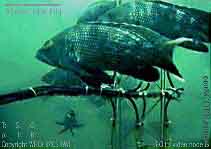| New Photos | Animal News | Animal Sounds | Animal Movies | Upload Photo | Copyright | Korean |
|---|
| Funny Animal Photos | Monsters in Animalia | Wiki Articles Fun Facts about Animals | Links | Home | Mobile A.P.A. |
|---|
| Image Info | Original File Name: Black Seabass (Centropristis striata) Sea Bass.jpg Resolution: 211x149 File Size: 12466 Bytes Upload Time: 2007:09:20 17:41:25 | |
| Author | Name (E-mail): Unknown | |
| Subject | Black Sea Bass (Centropristis striata) - Wiki | |
 |
| Email : E-Card | Poster | Web Master Delete Edit Info Admin |
| Description | Black Sea Bass (Centropristis striata) - Wiki
Black sea bass
The black sea bass (Centropristis striata) is an exclusively marine fish, also known as sea bass and blackfish. It inhabits the coasts from Maine to NE Florida and the eastern Gulf of Mexico. They are most abundant off the waters of New York. They can be found in inshore waters (bays and sounds) and offshore in waters up to a depth of 130 m. They spend most of their time close to the sea floor and are often congregated around bottom formations such as rocks, man-made reefs, wrecks, jetties, piers, and bridge pilings. General characteristics Black sea bass, as their name indicates, are usually black. But like many other types of fish, they have the ability to adjust their color to blend in with the bottom. Their colors may take on a gray, brown, black or even a deep indigo hue. The sides of their body may have dark vertical bands. But most distinctive is their skin, when seen up close resembles a fishnet pattern, because of the dark color that appears in the margin of their scales contrasted with the lighter color underneath the scales. The average sea bass weighs about 1½ lb (680 g). The world record bass is 9 lb 8 oz (4,309 g), but any sea bass above 5 lb (2.3 kg) is considered a large fish. As a sea bass matures, there are slight variations in their proportions. The smallest sea bass are often nicknamed “pin” bass. Larger fish are nicknamed “humpback” bass because as they grow larger they tend to bulk out just behind the head. Black sea bass feed on crab, bluecrab, juvenile lobster, shrimp, mollusks, small fish, herring, menhaden and squid. In contrast to the Striped bass Morone saxatilis, it is strictly confined to salt water. Life cycle The sea bass spawns when it is mature, at 190 mm, in middle of May to end of June. The eggs, 0.95 mm in diameter, are buoyant and their development time is 1.6 days at 23 °C. The maximum size of a sea bass is 500 mm, weighing 4.3 kg. It appears off New Jersey in the first weeks of May, withdrawing in late October or early November, and wintering offshore at 55 to 130 m at temperatures above 8 °C. In summer it is most abundant at less than 37 m. Diagnostic features The spiny and soft ray portions of the dorsal fin are continuous, so there is only one long fin instead of two short separate ones as for the wreckfish Polyprion americanus, scup Stenotomus chrysops, rose fish Sebastes marinus, cunner Tautogolabrus adspersus, striped bass Morone saxatilis. Rounded caudal fin and pectoral fins, short but high anal fins. Compared to a tautog or cunner, its mouth is much larger, also the caudal fin, pectoral fin, and soft portion (11 rays) of dorsal fin as long as spiny portion. Compared to a wreckfish, its scales are much larger, the head outline and gill cover are smooth, and the caudal fin is rounded at the edges. It is stout-bodied, three times taller than long (without caudal fin), and has a high back, flat topped head, moderately pointed snout, large oblique mouth, eye set up high (not as high as in the above image due to its slightly oblique perspective), and one sharp flat spine near the caudal end of the operculum. The dorsal fin originates at the anterior of the caudal end of the operculum, the soft portion of the dorsal fin is more tall than long, the caudal fin is rounded and in adults it is an elongated upper ray, the anal fin originates below the soft portion of the dorsal fin, which it resembles in its rounded shape and being more tall than long. The pectoral fin is very long nearly towards the anal fin, rounded (best fieldmark), the pelvic fin is very large, originate posterior of pectoral fin (whereas slightly caudate in scup, rose fish, cunner and striped bass, below in wreckfish). Scales are very large but it is naked at the head with adult males developing fatty bumps in front of the dorsal fin. It often rests stationary or cruises slowly around structures. It occasionally rests on the bottom or other structures, staying either head-down or head-up. It enters the smallest corners and caves with a body angle above ground often about 40° down. The dorsal fin is normally folded close to the body, and it is only spread out as an aggressive posture reaction to other sea bass. International names Black sea bass USA Black seabass UK Fanfre noir or Saint-Pierre France Kalliomeriahven Finland Perchia striata Italy Schwarzer Zackenbarsch Germany Serrano estriado Spain Serrano-estriado Portugal Svart havabbor Norway Svart havsabborre Sweden Μα??ρη Τσιπο??ρα (M??vri Tsipo??ra) Greece http://en.wikipedia.org/wiki/Black_sea_bass
| |||
| Copyright Info | AnimmalPicturesArchive.com does not have the copyright for this image. This photograph or artwork is copyright by the photographer or the original artist. If you are to use this photograph, please contact the copyright owner or the poster. |
|
|
|
| |||||||
| CopyLeft © since 1995, Animal Pictures Archive. All rights may be reserved. | ||||||||
Stats